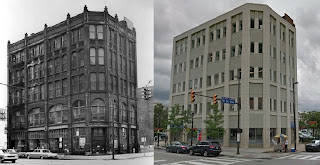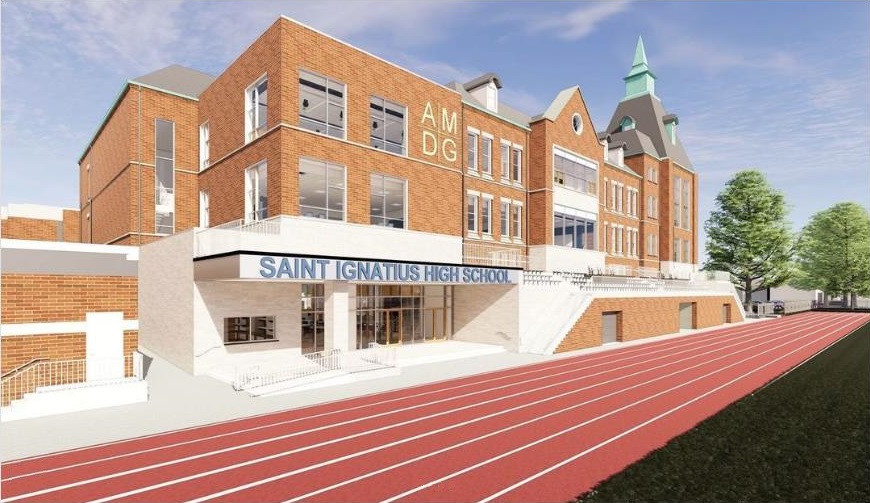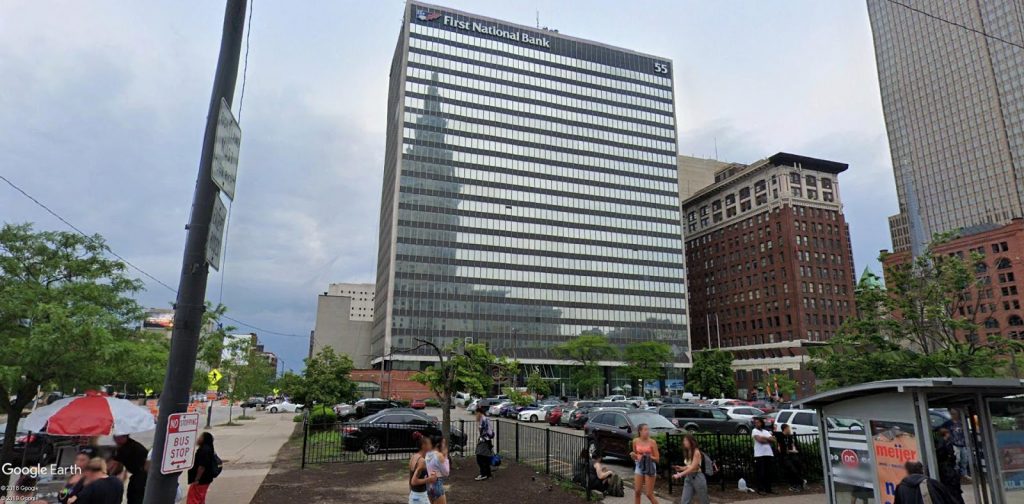UPDATED MARCH 12, 2020
Downtown Cleveland’s largest parking crater, the so-called “Superblock” where Sherwin-Williams (SHW) plans to build its new headquarters, has a sole survivor among its once vast building stock.
That monolith is set off to one corner of the Superblock, named because its sea of parking is actually spread among two blocks, separated by the one-way alley Frankfort Ave. The surviving building is the former Stark Enterprises headquarters that now belongs to 1350 W6 LLC, an affiliate of Realife Real Estate Group.
And the building may not be long for this world. There are two reasons why the building at 1350 W. 3rd St. is endangered. Ultimately, both reasons are apparently attributable to Realife which bought the building in the final days of 2018.
One is that Realife appears to want to sell the building, possibly to be associated in some way with SHW’s HQ. The other reason is that Realife allegedly hasn’t been making mortgage payments and may be forced to sell the building at a foreclosure auction.
According to a source, Realife reportedly had a potential tenant recently for 1350 W. 3rd. An Austin, Texas-based eCommerce firm named Zilker Technology was apparently intending on signing a lease here for its first Midwest office. But on or about Jan. 20, Zilker walked away due to some unfavorable stipulations in the lease.
“The language allowed for the lease to be terminated at any point, a result of developing situations with a future neighbor,” the source said. The future neighbor he referred to was SHW’s HQ.
Turning back the clock to Dec. 24, 2018, affiliates of Stark Enterprises and Realife entered into a mortgage in which Stark lent $1,650,000 to Realife and awarded a deed to the property at 1350 W. 3rd. Per the mortgage, Realife must make regular payments to Stark of $11,052.74 and get Stark’s permission for any improvements, demolitions or any other changes made to the property.
Realife representatives acknowledged the accuracy of the cognovit complaint and didn’t wish to appeal it, according to the Cuyahoga County Common Pleas Court docket. On Jan. 27, Common Pleas Judge Joseph D. Russo rendered a cognovit judgment of $1,671,782.25 plus 14 percent interest against Realife and associates.
A cognovit refers to a judgment entered after a written confession by the defendant without the expense of ordinary legal proceedings.
Despite Realife’s apparent lack of making regular payments on the Stark mortgage, the company has acquired $33 million worth of Greater Cleveland properties since it took title to 1350 W. 3rd, according to a Feb. 2 article in Crain’s Cleveland Business. And since 2015, Realife has acquired at least 55 properties throughout Greater Cleveland. It has received complaints that it has not maintained some of those properties.
| First page of Stark Enterprises’ complaint for foreclosure against Realife and affiliates filed last week (Cuyahoga County Common Pleas Court). |
Stark on Feb. 6 filed a complaint for foreclosure against Realife et al, requesting that the Common Pleas Court preserve the property at 1350 W. 3rd, that Stark’s mortgage be the first lien on the property and that the property be sold by the county with Stark paid by proceeds from the sale. Judge Cassandra Collier-Williams is overseeing the case.
Angelo Russo, attorney for Realife principal Yaron Kandelker, an Israeli citizen, did not return a phone message seeking comment prior to publication of this article.
The property in dispute is at the northeast corner of the Superblock, at the southwest corner of West 3rd Street and St. Clair Avenue. Despite its 1960s-era cladding in an attempt to modernize it, the building is 132 years old. It measures five stories and 18,000 square feet.
It’s all that’s left of a diverse collection of 19th-century and early 20th-century ornate warehouses, offices and other commercial structures that covered the nearly 6 acres of Superblock. Clearance of the Superblock, bounded by West 3rd and 6th streets, plus St. Clair and Superior avenues, began in the 1950s as highways began to intrude into the urban core.
The Superblock saw its last demolition in 2011 at the opposite corner, at West 6th and Superior. That’s when a parking deck wrapped around a check-cashing business was knocked down. Few knew that behind the modernized facade of the check-cashing business was a small brick structure that dated to the 1830s. It was used as a factory for everything from cigars to eyeglasses, but served as a restaurant for most of the 20th century.
As for the 1350 W. 3rd building, the Cleveland City Directory shows its original address was 182-184 Seneca Street prior to the city changing north-south street names to numbered streets based on their distance from Public Square. It was called The Gilman Building, according to building preservation consultant Steve McQuillin.
The Gilman Building was designed by anarchist/socialist architect John Edelman, mentor to the famous architect Louis Sullivan, who credited Edelman with the concept of form follows function, McQuillin said.
Built in 1882 for the A.S. Gilman Printing Co., it later had tenants like the Ingraham Brush Works and the tobacco firm G.H. Mack & Co. It also had a billiards hall on the ground floor, according to Sanborn Fire Insurance maps of the late 1800s. More printing companies filled the building into the 1900s in a neighborhood once filled with printing, bindings and publishing companies.
Neighbors included the early addresses of the Cleveland Plain Dealer (southeast corner of Bank [West 6th] Street and Frankfort) and the Cleveland Press (on Seneca [West 3rd] just north of the Lake Shore & Michigan Southern Railway’s offices that were at the northwest corner of Seneca and St. Clair.
Next door to 1350 W. 3rd on the St. Clair side was a dilapidated livery stable for storing wagons and re-shoeing horses. To the south, along Seneca/West 3rd was the Northern Ohio Fair Building to which the A.S. Gilman Printing Co. relocated. Gilman’s most notable effort was its publishing of the weekly American Sportsman.
END






